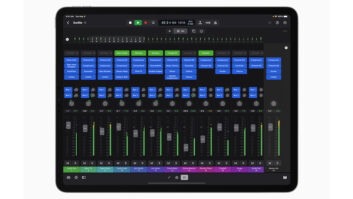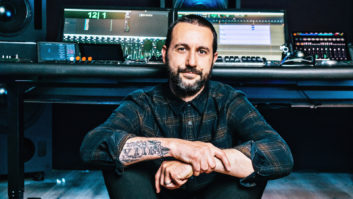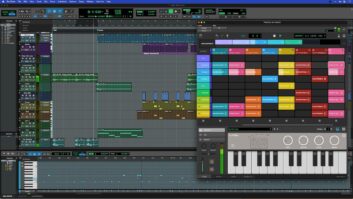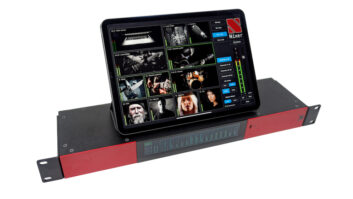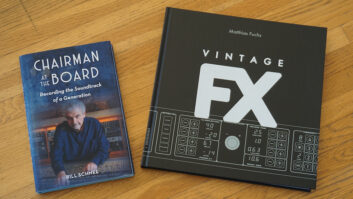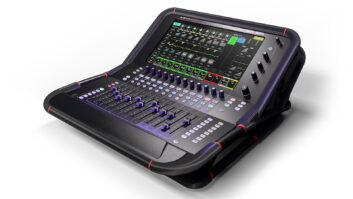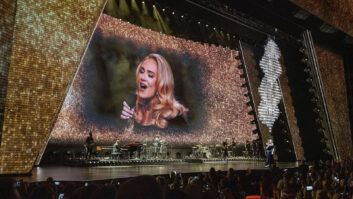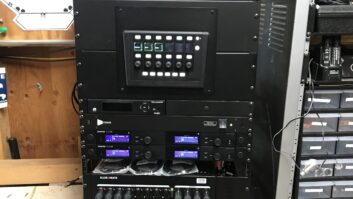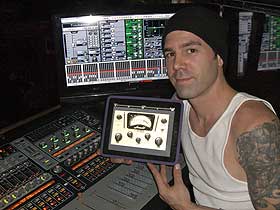
Troubadour house engineer Bobby Crown at the Avid VENUE SC48 with Smack! plug-in shown on the iPad
Photo: Keishi Nagasaku
It can be argued that Apple’s iPad has changed the way people make music. But for mixing a live show? You bet. Granted, you won’t be seeing front-of-house engineers at the next arena date walking around the floor, pushing “faders” up and down on an iPad while the digital console sits idle. But for smaller venues of 1,000-capacity and below—where house (and visiting) engineers are contending with multi-levels, multi-zones and an FOH board in a less-than-ideal spot—you may start seeing more iPad-mixed shows. And that’s exactly what house engineer Bobby Crown of the famed Troubadour club (Los Angeles) is doing.
Crown, who has been with the venue for the past eight years, has been spearheading the club’s audio upgrades, fighting for a digital console to replace its aging analog boards, garnering a loaner Avid VENUE (and later purchasing that digital console) and generally leaning toward more computer-based processing. And then he took it one step further: “When the iPad came out, I knew that I could use it to mix,” Crown says. “So I waited five months and checked out some people online who were messing around with it and found a screen-sharing program [iTelePort] that allows the iPad to capture the [SC48’s] screen and control the console remotely. I finally went out and bought an iPad to strictly mix the show; the only apps I have on it are audio apps, and I leave it at work.
“As soon as I got the iPad working with the SC48, it really opened up the doors even wider than when we got the digital console,” he continues. “It allows you to be completely remote; you don’t have to be stuck behind the console anymore. You can walk around and utilize every feature the console has because the Avid [VENUE] software is able to be seen on the screen.” Crown connects the router to the back of the SC48 via Ethernet out and assigns the IP address to the iPad. As soon as he turns on the app, the console screen is at his disposal and is ready for soundcheck.
“So now that we’re onstage and the band’s loading in, I can troubleshoot all the monitors; I can send pink noise throughout the whole system and verify that each monitor works. If it doesn’t, I can stay downstairs, go to the amp and figure out what the problem is to fix it [instead of making numerous trips from console to stage and back again]. The bands see that their engineer—whom they haven’t met before—is doing something to help them along and immediately become very comfortable. Once we get all the monitors ringed out and we know they’re verified, we plug in all the microphones based on the band’s input list, and I can stay onstage and walk right up to the monitor and hear if things are working or not working correctly and fix it. It just gives you a better understanding of what’s happening onstage because you’re there.”
For the most part, this is standard fare if a band comes in sans engineer; when a group does come in with their own audio tech, that engineer will work on the SC48 while Crown and his second-in-command, Sean Myers, use the iPad to monitor those mixes and help—on-the-fly—if needed.
At showtime, Crown can be seen at the Avid board—which can be used for both FOH and monitor duties—making sure that all is working as it should. After the first song, once Crown and crew feel comfortable with how things are sounding, he’ll start walking the floor, mixing with the iPad. “It’s such a small club, once it gets full you can stay on the floor and mix, which we’ve done, but then you run into issues where people are right next to you and want to know what you’re doing and distracting you,” he adds. “We try to stay at the console for the show, but we do walk around a lot.” You won’t find Crown mixing from a moshpit, but he hasn’t found any problems from the occasional bump from a club patron—nor has he experienced any latency issues with the router. “I had expected to see that when you move a fader, you’d have to wait a second to hear the result, but that hasn’t happened. It’s really instantaneous.”
Asked if he misses the “tactile” feel of using a physical board, Crown replies: “Yes and no. Having a graphic EQ for the front-of-house EQ, that was something that I missed only because back in the analog days things were never solid. It was never a comfort zone of sound; it could go any way at any moment, and you had to always have your hands on it. Having that hands-on tactile response, there’s things I miss about it, but now that I know how the console feels with a mouse and the knobs and faders that it provides, I don’t really want to go back—ever. From the beginning of my career in live sound until now, this is the closest I have ever been to feeling fully connected to my responsibilities as a professional live sound engineer. The ability to adjust any input or output—with no limitations, at any position in my mixing environment—at the same time delivering the desired result in the time expected is the ultimate rush any sound engineer can have!”
